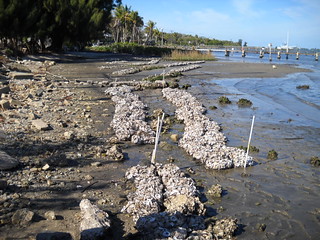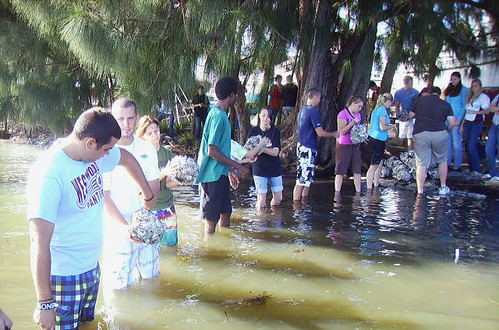Oysters are loved by seafood connoisseurs around the world, but these briny mollusks are much more than a taste treat. They also provide important benefits to a healthy coastal environment.
Oyster reefs act as natural filters to improve water quality, stabilize shoreline and provide habitat for young fish and other marine life. Unfortunately, oyster populations in the U.S. and around the world have been declining. This loss has been especially devastating for the Indian River Lagoon on Florida’s Atlantic coast, which has seen an 80 percent decline in oyster populations.

The Indian River Oyster Reef Restoration Program has resulted in nearly 2 miles of new oyster reefs in the lagoon. The new reefs are made up of bag oyster shell, collected from area restaurants.
Florida Sea Grant is responding by partnering with St. Lucie County and the Florida Oceanographic Society to create a volunteer-based program of reef restoration that has, since its creation in 2006, resulted in over 2 miles of new oyster reef in the Indian River Lagoon.
Each year, the program expands in scope and participation.
Florida Sea Grant extension agent LeRoy Creswell helps coordinate the it.
“We’ve had a lot of success,” said Creswell. “We aren’t just bringing oysters back to the lagoon. The program is helping us educate our entire community about the importance of oysters. Even the area restaurants are involved—that’s where we get all of our oyster shells.”
More than 200 adult and school-age volunteers participated in the program last year, logging more than 400 hours. They help bag the oyster shells that serve as the foundation for the new reefs and then relay the heavy bags into place, all the while getting a hands-on lesson in oyster ecology provided by Creswell.
In 2012 alone, volunteers put out four new reefs in the Indian River Lagoon. Each reef covers approximately a quarter-acre of lagoon bottom, and is made up of 3,200 oyster shell bags weighing an estimated 55 tons. Deploying a reef isn’t as simple as pitching bags of discarded shell into the lagoon, warns Creswell. That could be seen as pollution.
“The toughest part of deploying new reefs is the permitting process,” he said. “You have to get permits from the Department of Environmental Protection and the U.S. Army Corps of Engineers. Years of experience have taught us how to streamline the process.”
To make future restoration efforts even easier, Creswell is working with Florida Sea Grant legal specialist Tom Ankersen and University of Florida Levin College of Law Conservation Clinic students to advise a statewide work group that is developing draft language to create a “general permit” for small-scale oyster reef restoration efforts. If the rule is adopted, restoration efforts that comply with its language will not have to spend precious time and resources obtaining permits for individual projects.




